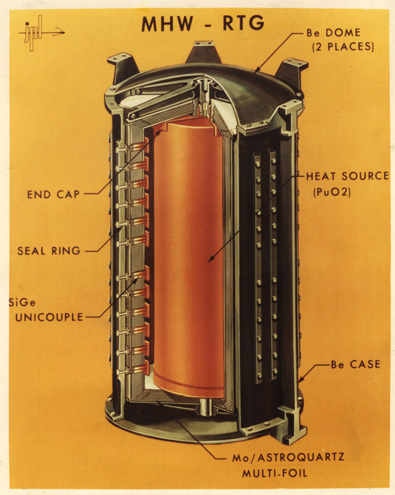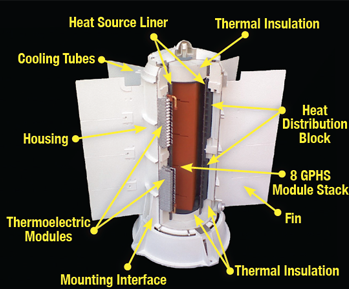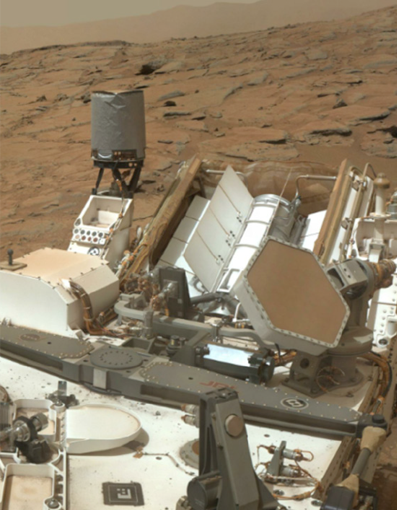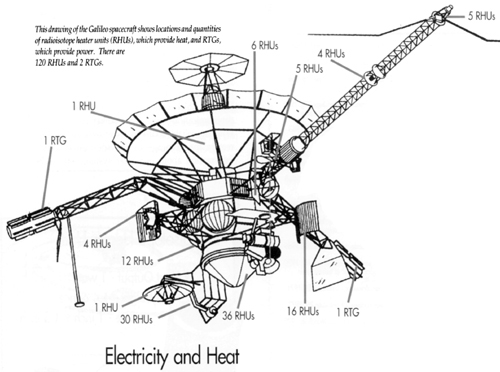Radioisotope Thermoelectric Generators
The fact that two dissimilar metals in contact produce a junction emf raises the possibility that such junctions could provide a way to generate electric power. The drawback for most practical applications is the small size of the junction emf, on the order of 10-6 volts/K, so to get a practical output voltage to make a thermoelectric generator, a number of them are often combined in series and placed in a very high temperature environment.
A major practical application of thermoelectric generators has been in the space program, where the need is for an electric generator with no moving parts and one which will supply power for the long duration of the space missions. This need has been met in the U.S. space program by using the heat from radioisotope decay applied to a collection of junctions in what is called a Radioisotope Thermoelectric Generator (RTG). At the time of landing of the Mars Science Laboratory in August of 2012, the United States had launched 45 RTGs as parts of 26 space missions. RTGs have been used by NASA on many missions including Apollo, Pioneer, Viking, Voyager, Galileo and Cassini.
 | The power sources for Voyager are still operating after over 35 years of operation. The high temperatures required for the thermoelectric generation are provided by the decay of Plutonium-238 in the form of its oxide PuO2. |
| Pu-238, with its half-life of 87.7 years, has been the heat source of choice for the space program. After five years, approximately 96 percent of the original heat output of Pu-238 is still available. |  |
Because the nuclear fuel in RTGs is radioactive, safety is a critical issue. As it decays, Pu-238 emits radiation mainly in the form of alpha particles, which have a very low penetrating power. Only lightweight shielding is necessary because alpha particles cannot penetrate a sheet of paper. Radioisotopes producing more penetrating radiation, such as beta or gamma particles, would be more difficult to handle safely and would require heavier shielding, a distinct drawback on space missions.
 | The Curiosity rover on Mars is the first rover powered by thermoelectrics using a Multi-Mission RTG (MMRTG).This is a model of the MMRTG from NASA . This unit produces 110 watts of power at launch and is designed to operate for 14 years. |
This is a self-portrait of the Curiosity rover on Mars which shows the MMRTG at the back of the image. |  |
The first RTG used in a space mission was launched aboard a U.S. Navy transit navigation satellite in 1961. The RTG, named Space Nuclear Auxiliary Power -3 (SNAP-3) had an output of only 2.7 watts, but it continued to perform for 15 years after launch. Astronauts on five Apollo missions left RTG units on the lunar surface to power the Apollo Lunar Surface Experiment Packages. One of the units placed on the Moon by Apollo-12 astronauts provided 73 watts of power and lasted over eight years.
The Galileo spacecraft had two RTG's that produced 285 watts each to power the spacecraft plus 120 Radioisotope Heater Units (RHUs) which provided heat to protect delicate instruments in the extreme cold of space.

DC Circuits
Emf Concepts
Reference:
Kip, Section 7.7
History of Thermoelectrics, UCLA
Space Power
| HyperPhysics***** Electricity and Magnetism | R Nave |